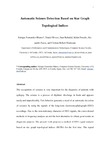Mostrar o rexistro simple do ítem
Automatic Seizure Detection Based on Star Graph Topological Indices
| dc.contributor.author | Fernández-Blanco, Enrique | |
| dc.contributor.author | Rivero, Daniel | |
| dc.contributor.author | Rabuñal, Juan R. | |
| dc.contributor.author | Dorado, Julián | |
| dc.contributor.author | Pazos, A. | |
| dc.contributor.author | Munteanu, Cristian-Robert | |
| dc.date.accessioned | 2021-03-24T15:46:09Z | |
| dc.date.available | 2021-03-24T15:46:09Z | |
| dc.date.issued | 2012-08-15 | |
| dc.identifier.citation | Fernandez-Blanco, E., Rivero, D., Rabunal, J., Dorado, J., Pazos, A., & Munteanu, C. R. (2012). Automatic seizure detection based on star graph topological indices. Journal of neuroscience methods, 209(2), 410-419. | es_ES |
| dc.identifier.issn | 0165-0270 | |
| dc.identifier.uri | http://hdl.handle.net/2183/27587 | |
| dc.description.abstract | [Abstract] The recognition of seizures is very important for the diagnosis of patients with epilepsy. The seizure is a process of rhythmic discharge in brain and occurs rarely and unpredictably. This behavior generates a need of an automatic detection of seizures by using the signals of long-term electroencephalography (EEG) recordings. Due to the non-stationary character of EEG signals, the conventional methods of frequency analysis are not the best alternative to obtain good results in diagnostic purpose. The present work proposes a method of EEG signal analysis based on star graph topological indices (SGTIs) for the first time. The signal information, such as amplitude and time occurrence, is codified into invariant SGTIs which are the basis for the classification models that can discriminate the epileptic EEG records from the non-epileptic ones. The method with SGTIs and the simplest linear discriminant methods provide similar results to those previously published, which are based on the time-frequency analysis and artificial neural networks. Thus, this work proposes a simpler and faster alternative for automatic detection of seizures from the EEG recordings. | es_ES |
| dc.description.sponsorship | Xunta de Galicia; 2007/127 | es_ES |
| dc.description.sponsorship | Xunta de Galicia; 2007/144 | es_ES |
| dc.description.sponsorship | Instituto de Salud Carlos III; PIO52048 | es_ES |
| dc.description.sponsorship | Instituto de Salud Carlos III; RD07/0067/0005 | es_ES |
| dc.description.sponsorship | Ministerio de Ciencia e Innovación; TIN2009—07707. | es_ES |
| dc.language.iso | eng | es_ES |
| dc.publisher | Elsevier | es_ES |
| dc.relation.uri | https://doi.org/10.1016/j.jneumeth.2012.07.004 | es_ES |
| dc.rights | Atribución-NoComercial-SinDerivadas 3.0 España | es_ES |
| dc.rights.uri | http://creativecommons.org/licenses/by-nc-nd/3.0/es/ | * |
| dc.subject | Automatic signal processing | es_ES |
| dc.subject | Epilepsy seizure detection | es_ES |
| dc.subject | EEG signal | es_ES |
| dc.subject | Star graphs | es_ES |
| dc.subject | Linear discriminant analysis | es_ES |
| dc.title | Automatic Seizure Detection Based on Star Graph Topological Indices | es_ES |
| dc.type | info:eu-repo/semantics/article | es_ES |
| dc.rights.access | info:eu-repo/semantics/openAccess | es_ES |
| UDC.journalTitle | Journal of Neuroscience Methods | es_ES |
| UDC.issue | 209 | es_ES |
| UDC.startPage | 410 | es_ES |
| UDC.endPage | 419 | es_ES |
| dc.identifier.doi | 10.1016/j.jneumeth.2012.07.004 |
Ficheiros no ítem
Este ítem aparece na(s) seguinte(s) colección(s)
-
GI-RNASA - Artigos [193]






